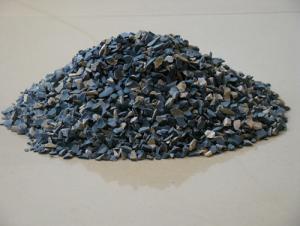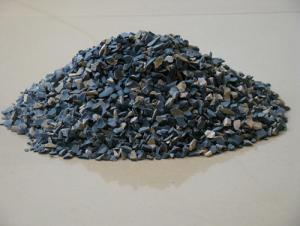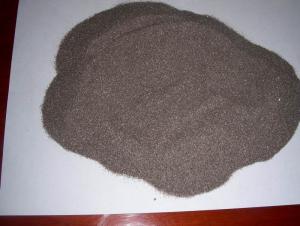Refractory Raw Materials-Dead Burnt Magnesite Materials
- Loading Port:
- Tianjin
- Payment Terms:
- TT OR LC
- Min Order Qty:
- 20 m.t.
- Supply Capability:
- 1000 m.t./month
OKorder Service Pledge
OKorder Financial Service
You Might Also Like
Dead-burned magnesite is selected from natural magnesite, calcined temperature and the shaft kiln. It is the material of ordinary magnesia bricks, shaped and unshaped refractory products.
Specification
Application
It is used for steelmaking furnace bottom and ramming furnace.
In the same condition, using manganese or silicon to deoxidize separately, the burn out rate are 46% and 37%, but it is only 29% if using manganese alloy to deoxidize. So, it is used widely to smelting steel and its output increases faster than ferroalloy's, so has become an indispensable composite deoxidizing and alloy additives in steel industry. The silicon-manganese which contains carbon below 1.9% still is used to produce medium/low-carbon ferromanganese and semi-finished products of electro silicothermic process manganese metal.
- Q:Why do magnesium oxide refractory bricks can be made into refractories?
- Because the magnesium oxide, commonly known as magnesia, which is a basic oxide, with the common property of alkali oxides and belongs to the cementitious material . It is white or light yellow powder, odorless, tasteless, non-toxic and a typical of alkaline earth metal oxide, whose chemical formula is MgO. It is white powder, with melting point of 2852 ℃, boiling point of 3600 ℃ and relative density of 3.58 (25 ℃). The magnesium oxide that is soluble in acid and ammonium hydroxide solution has high insulation properity. After high temperature of above 1000 ℃ burning, it will transform into crystals, and when rising above 1500 ℃ , it will turn into dead-burned magnesium oxide (also known as the magnesia) or sintered magnesia. So the performance of magnesium oxide refractory bricks is good, and the fire resistance of it is very strong.
- Q:What needs to be noted when choosing and using blast furnace fireproof materials? Who knows?
- there are different temperatures in various parts of the blast furnace, thus using different types of refractory.
- Q:What are the commonly used fire protection materials
- Firewall. The fire wall is made of non combustible material, and is directly installed on the base of the building or the reinforced concrete frame or fire proof walls . Fireproof limit of the firewall, according to the current "building regulations", is 4 hours, wheras the specification of Technical specification for concrete structures of tall building is 3 hours. doors resistant to fire, heat in a certain period of time These door usually prevent the spread of fire and gas in the fire resistant wall, staircase, pipe well. Fire door can be divided into steel fire doors, wood fire doors and composite materials fire door according to the material used. According to the limit of fire resistance can be divided into the class A fire door (1.2h), B fire doors (0.9), class C fire door (0.6h); (3) fire window. Windows resistant to fire, heat in a certain period of time It is usually installed in the fire resistance wall or doors; the fire shutter. This roller shutter can be refractory in a certain period of time. It is typically used for heat and fire insulation in escalator with difficulties to install fire resistant wall, fire resistant valve and smoke resistant valve. Fire resistant valve is installed in the ventilation and air conditioning system of air supply and return air duct, usually in the open state, fire, It will be turn off when the pipeline gas temperature reached 70 degrees, can meet the requirement for fire resistance and insulation for gas and fire. Smoke fire resistant damper installed in the exhaust system pipe, when the pipeline gas temperature reached 280 degrees, it will close automatically, insulating fire and gas.
- Q:what's the standard of fireproofing material?
- Class A1 is divided according to the combustion performance of GB8624-2006 building materials and products. Specific technical index requirements are: 1, the temperature rise ≤30 degrees;mass loss rate ≤50%; combustion duration time is 0; 2, main components, overall products, gross calorific value of external secondary components ≤2.0MJ/kg; any inner secondary component ≤1.4MJ/kg; (there are difference between homogeneous and non-homogeneous). Z802 building materials noninflammability testing furnace has to be used for testing technical indicators mentioned in test 1, using Z805 building materials combustion heat value to test technical indicators mentioned in test device 2.
- Q:What kind of fireproof material is used for steel structure?
- Brushing or spraying the coating on the surface of steel structure to prevent burning and insulate heat. It also prevents undermining the rolled steel from rapid temperature elevation and avoid collapse of building for lose of supporting capacities. Agglutination material are classified as fireproof coatings for steel structures which is solvent based and Water-based steel structure fire retardant coatings. Fireproof coatings for steel structures which is solvent based are subdivided into fireproof coatings for steel structures which is solvent based with low benzene content and fireproof coatings for steel structures which is solvent based with high benzene content (TVOC≤600g / L, benzene ≤5g / kg). It can be divided by thickness. ultra-thin (CB) fireproof coatings (coating thickness ≤3mm), thin (B) fireproof coatings (3mm & amp; lt; coating thickness ≤7mm) and thick (H) steel structure fire retardant coating (7 mm & amp; lt; coating thickness ≤45㎜).
- Q:What are the fire resistance ratings of the glass partition?
- The glass partition system is composed entirely of metal structures, glass, color plate and other materials which also has fire resistance capacity. When the inner structure of the system is steel structure, the fire resistance of which is 30 mins, 60mins or even longer. The fireproof glass is a special glass which is able to maintain its integrity and insulation in a fire resistance test. According to fire resistance performance, it can be divided into three categories: Class A: The fireproof glass which meets demands of fire integrity and fire insulation at the same time. This glass has advantages of excellent transmittance, fire-proofing(smoke resistance, fire insulation, and blocking heat radiation), sound insulation and impact resistance. It can be applied to architectural ornaments, fire resistant timber doorsets with steel structure, windows, upper beam, partition walls, daylighting roofs, ceiling screens, perspective floor and other building components which need transparency and fireproofing. Class B: The fireproof glass which meets demands of fire integrity and thermal radiation intensity at the same time. This glass is mostly composite fireproof glass which has advantages of transmittance, fireproofing, and smoke resistance. Class C: The fireproof glass which only meets demand of fire integrity. This glass has advantages of transmittance, fireproofing, smoke resistance and high intensity. It can be applied to fireproof glass partition walls, fire windows and with no requirements on outdoor curtain walls, etc. The fireproof glass can be classified as composite fireproof glass and single chip fire-proof glass in terms of structure.
- Q:Does anyone know what kind of light fireproof materials are there?
- 二, 1, Gypsum plaster board With the building plaster as main raw material, gypsum plaster board is a kind of processed plate made by a special board for protective with an addition of additives and fibers as board core. Gypsum plaster board is characterized by light weight, sound insulation, heat insulation, strong processing performance and simple construction method. 2, Gypsum block Gypsum block is a kind of lightweight building gypsum product which is mainly made of building gypsum, and by adding water, stirring, casting and drying. During the process, , the fiber reinforced materials or light aggregates are allowed in, and the foaming agent can also be added. It has many advantages, such as sound insulation and fire prevention, convenient construction and so on. It is a kind of new and healthy wall material which produces low carbon, enhances environmental protection, and caters to the the times. 3, Fly ash brick is a new type of wall material, and bulk density is one of the main technical indexes. The weight of bulk density can be controlled according to the need of construction and adjustment of technical formula. The dry bulk density of the fly ash brick is about 1540 to 1640 kg / m 3, slightly lighter than the clay brick (1601800 kg /m 3). The flexural and compressive strength of fly ash brick is mainly determined by the production process, the formula and the hydrothermal synthesis reaction mode as well as the need of construction. According to the standards of architectural material industry (JC239 - 2001) released by People's Republic of China, the average value of the flexural strength is 2.5 ~ 6.2Mpa, compressive strength is between 10 ~ 30Mpa. I hope this will be helpful to you
- Q:It the Special Fire-Proof Material belonged to ceramics? Is there a national standard of the Special Fire-Proof Material?
- The fiber and reinforcing material of the metal ceramic is also belonged to the Special Fire-Proof Material. ~~~~GB is too much trouble, GB online should ~~~ Lei Bao Refractories for you. The high temperature inorganic coating. 5. The refractory compound. 3. The high melting point oxide. You can search it on the internet according to the classification~~~~ The special refractories can be divided into five categories: 1. metal ceramic
- Q:Concrete composition and function of magnesia bond used in refractory
- Mainly high purity magnesia powder and silica fume, in accordance with the 4:1 ratio of the mixture, that is, we often use in the castable MgO-SiO2-H2O binding system! Compared with cement, the content of CaO is lower, the high temperature strength of the product is increased, and the slag corrosion resistance of the product is increased!
1. Manufacturer Overview |
|
|---|---|
| Location | |
| Year Established | |
| Annual Output Value | |
| Main Markets | |
| Company Certifications | |
2. Manufacturer Certificates |
|
|---|---|
| a) Certification Name | |
| Range | |
| Reference | |
| Validity Period | |
3. Manufacturer Capability |
|
|---|---|
| a)Trade Capacity | |
| Nearest Port | |
| Export Percentage | |
| No.of Employees in Trade Department | |
| Language Spoken: | |
| b)Factory Information | |
| Factory Size: | |
| No. of Production Lines | |
| Contract Manufacturing | |
| Product Price Range | |
Send your message to us
Refractory Raw Materials-Dead Burnt Magnesite Materials
- Loading Port:
- Tianjin
- Payment Terms:
- TT OR LC
- Min Order Qty:
- 20 m.t.
- Supply Capability:
- 1000 m.t./month
OKorder Service Pledge
OKorder Financial Service
Similar products
New products
Hot products
Hot Searches
Related keywords



























